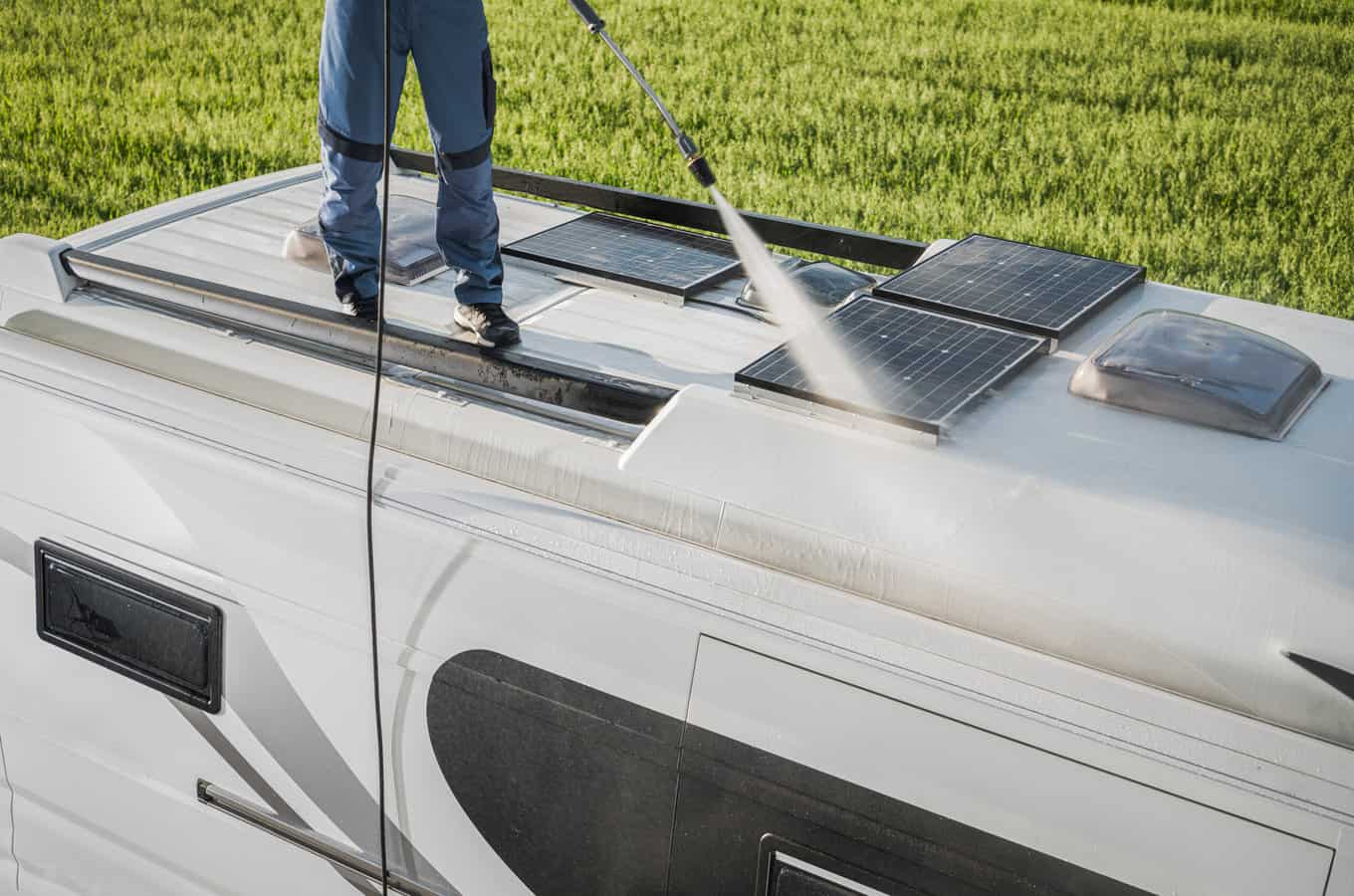When thinking of RV solar power, many RVers think the process starts and ends with solar panels. They seldom give a second thought about the status of the battery, or battery bank. That is, until there’s no juice left to power lights, pumps, and appliances when camping off-grid during a multi-day trip. If a generator isn’t handy, panic mode and frustration step in. That’s why batteries are a vital part of any RV solar power system.
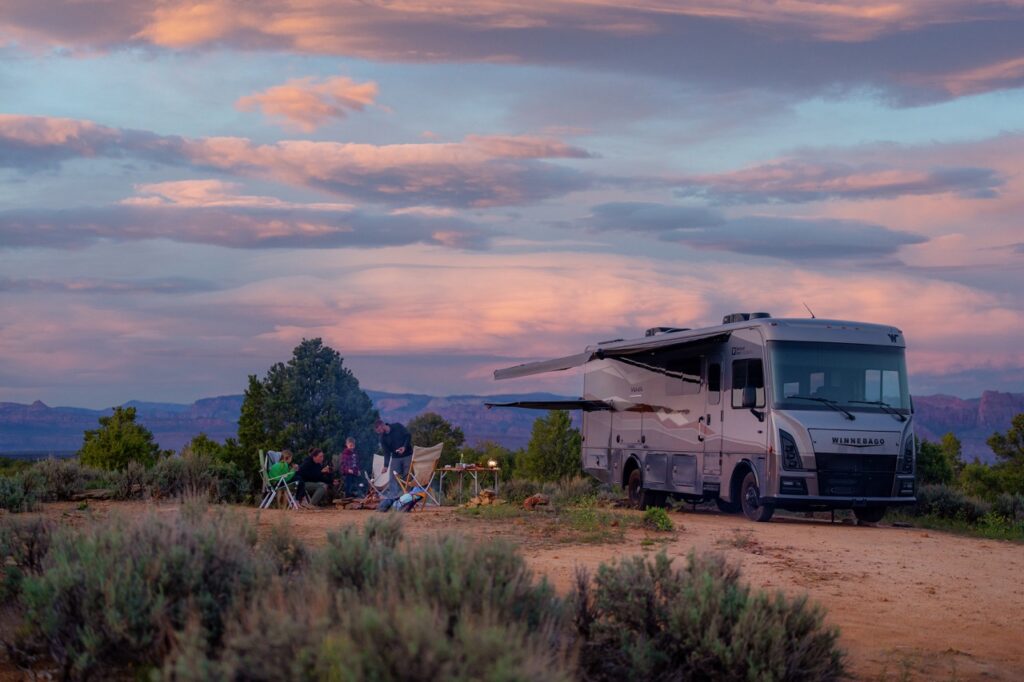
Loss of battery power can be avoided when your RV’s 12-volt battery system and RV solar power are sized properly.
Manufacturers of off-grid capable travel trailers have been installing roof-mounted solar panels for years, along with deep-cycle batteries to take the charge and handle the electrical load that comes with extended camping time while unplugged.
Up until the last year or two, many of these types of trailers, toy haulers, and camper vans came from the factory with a single 100-watt solar panel to provide a minimal charge to the RV’s deep-cycle lead-acid, lithium-ion (Li-on), or LiFePO4 battery or battery bank. Today, one or more 200-watt solar panels are becoming more of the norm, along with much more efficient Li-on batteries.
Boosting RV Solar Power
“The daily power output of a 200-watt [solar] panel is around 1,000–1,500 watt-hours, which is sufficient for interior lighting, charging devices, and running a few appliances,” says Bluetti Power, a well-known supplier of solar systems including RVs. “If you want to enjoy air-conditioning or watch a complete game on TV, it can’t happen with the output from a single 200-watt panel.”
RVs have become much better in that arena over the past couple years. Today, many RVs designed for off-grid camping come standard with more than 200 watts of roof-mounted RV solar power. Plus, those panels are now feeding the latest in high-end Lithium-Ion deep-cycle battery technology.
Stepping Up To 48/51V Batteries
The newest RV solar power trend is ditching 12-volt batteries for 48-/51-volt battery systems with inverters. These systems change the DC voltage coming from the solar panels and battery to power the RV’s 12-volt needs.
“The 48V or 51V systems will become more prevalent as they are adopted by more RV manufacturers and conversion companies,” says Dan Musto, Lithioinics Battery production manager. “That’s because these systems provide great energy storage capacity, they are far more efficient than 12-volt, have faster charging times, smaller cabling requirements, and less amps (read: less heat) flowing through cables.”
Winnebago is one of the manufacturers embracing 51-volt battery power. The Power Max system in the 2024 Revel is a prime example of utilizing a 51-volt battery system and 220-watt solar panels to give RVers a totally state-of-the art energy storage system. It delivers unprecedented off-grid power to enjoy multi-day excursions deep in the boonies.
Amp Hours Versus Watt Hours
When you are shopping for a new RV to camp off-grid for multiple days at a time, it pays to sort out the potential drain on that particular RV’s battery system. You need to make sure it will handle the job without having needing more upgrades after the purchase. This requires a little math. I know, ugh!
No worries, it’s actually simple math.
Batteries are usually rated in Amp-Hours (Ah). Electrical consumption is measured in Watt-Hours (Wh). To understand how long the battery (or battery bank) in your RV can theoretically last during a camping trip relying entirely on battery/solar power first requires converting the battery’s Ah into Wh.
The conversion formula: Ah x V = Wh
For example, if the RV has a 240Ah Li-on battery powering a 12-volt system, the battery has a 2,880Wh capacity. If the system is a 51-volt version, utilizing a pair of 165Ah Lithionics batteries like found in the Revel, the watt-hours jump to a whopping 16,830.
Figuring Electrical Consumption Off-Grid
“Many appliances and devices in RVs are rated by their power consumption in watts,” says an Enduro Power Batteries blog that goes into great detail about choosing the right batteries for off-grid RV use. “So you will want to identify the power draw of each appliance and estimate the amount of time that you might use them to have an idea of how many watt-hours of battery power you will need in your battery bank.”
The second step is figuring out the electrical consumption (in watts) of all the appliances and devices used during a typical camping trip, and how many hours a day each is used.
The formula: Watts x Hours = Watt-Hours (Wh)
For instance, a True single-burner induction cooktop (1,750 watts) is used ½-hour a day, it consumes 875Wh (1,800x.5 = 875). A 12-volt refrigerator/freezer, such as a 10 cu-ft Furion model found in many RVs, used 24/7, consumes about 1,080 Watt-Hours a day. Between the two they will draw about 2,625Wh per day.
You can spend a lot of time compiling electrical drain on the system by using the above formulas. You could also take the easy route and use a power energy meter to do the work for you.

Battery Re-charging With Solar Panels
Naturally, an RV battery must be replenished (charged) to supply continuous power to the RV’s 12-volt electronics. A lead-acid battery can be drained to 50-percent capacity, while a Li-on battery can be discharged to about 80 percent. Both need to be continuously recharged when used off-grid. That’s done via the solar power system’s charge controller.
Then there’s the issue of the solar panels’ actual contribution to the RV’s power grid. After all, camping isn’t always going to be under clear skies and bright sun.
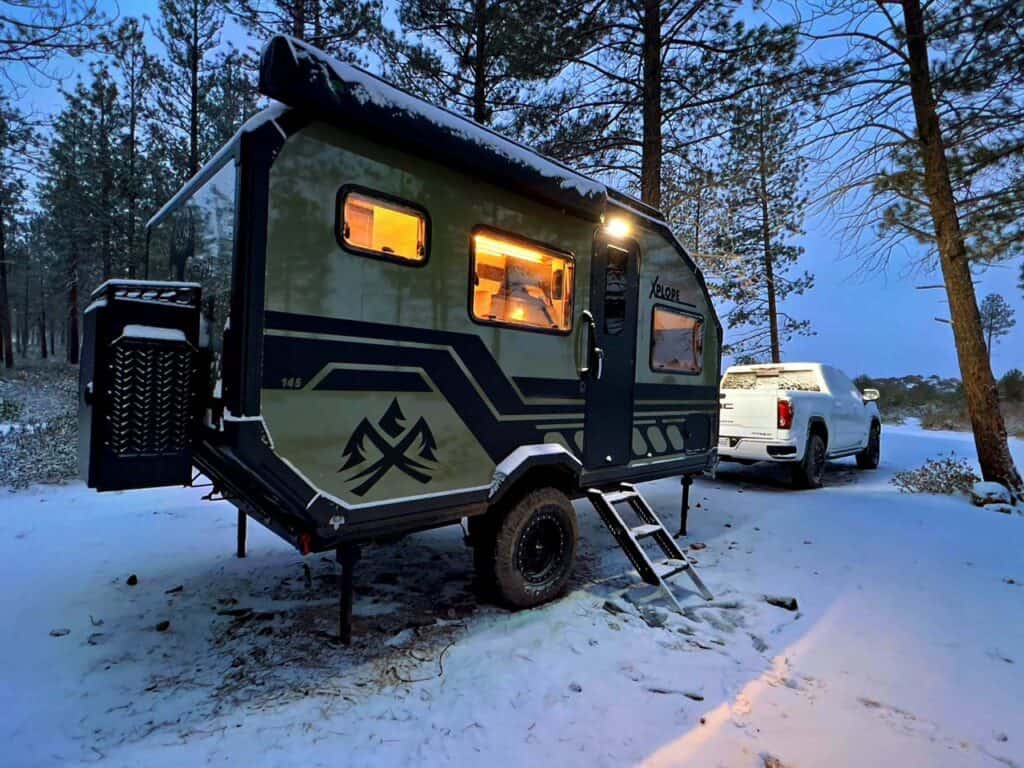
Bluetti, AmSolar, Anker and other experts in solar power remind us that a solar panel’s efficiency depends on a number of factors. They include the outside temperature, angle of the sun, shadows cast by trees, amount of cloud cover, and even the amount of air pollution. All reduce the amount of the sun’s energy hitting the solar panel cells.
Solar experts say, on average, an RVer should only count on a 200-watt solar panel to generate about 60Ah per day. When selecting batteries for the solar-charging system, experts suggest matching the output of the solar-panel array to the amp-hour rating of the batteries. Batteries need to be brought up to a full charge regularly in order to keep them healthy. To do so it’s recommend between a .5:1–2:1 ratio of solar panel output to battery amp-hours for proper charging ability. That’s equal to a 100-watt–400-watt solar-charging system feeding a 200Ah battery.
Great Off-Grid RVs With Extra Battery/Solar Muscle
Looking for an off-grid RV that has enough onboard battery muscle to handle extended-stay camping trips? Here are just a few of the 2024 models, in no particular order. Each come with 200-watt-plus solar panels, along with enough battery power to support up to week-long dry camping excursions without cranking up a generator. All prices listed are base msrps.
Surveyor 19SSLE
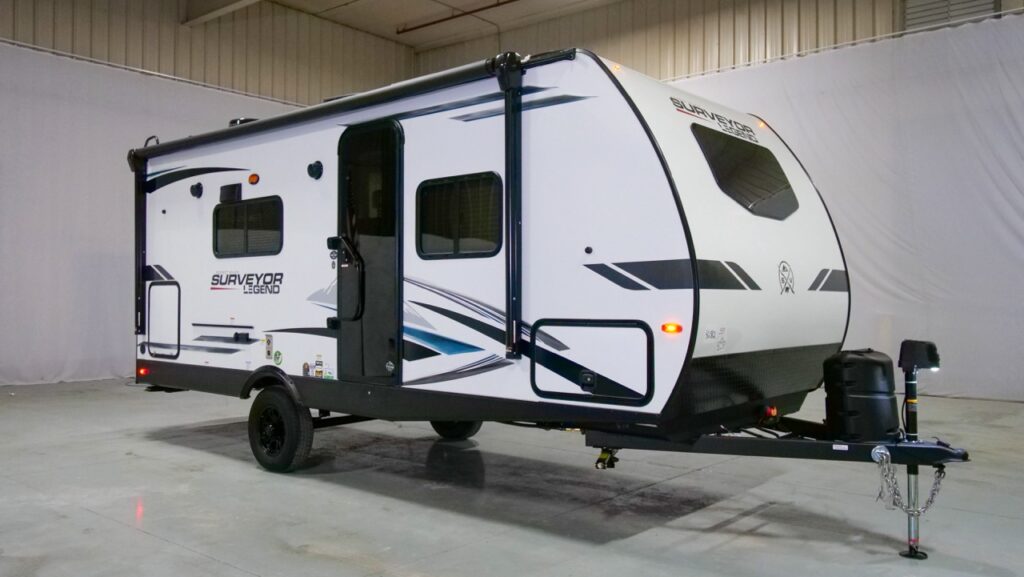
Starting with the 2024 models, all Surveyor Legend travel trailers come standard with twin 200-watt solar panels. The 24-foot-long Surveyor 19SSLE ($43,267) is one of the top-selling trailers in the Forest River line. It’s lightweight at 4,128 pounds (UVW) and has a slide on the streetside to open up the galley/lounge area. An outside griddle, large awning, comfortable rear bathroom, and a north-south residential Queen bed make this a nice package for off-grid RVs and extended stays.
No Boundaries 19.6
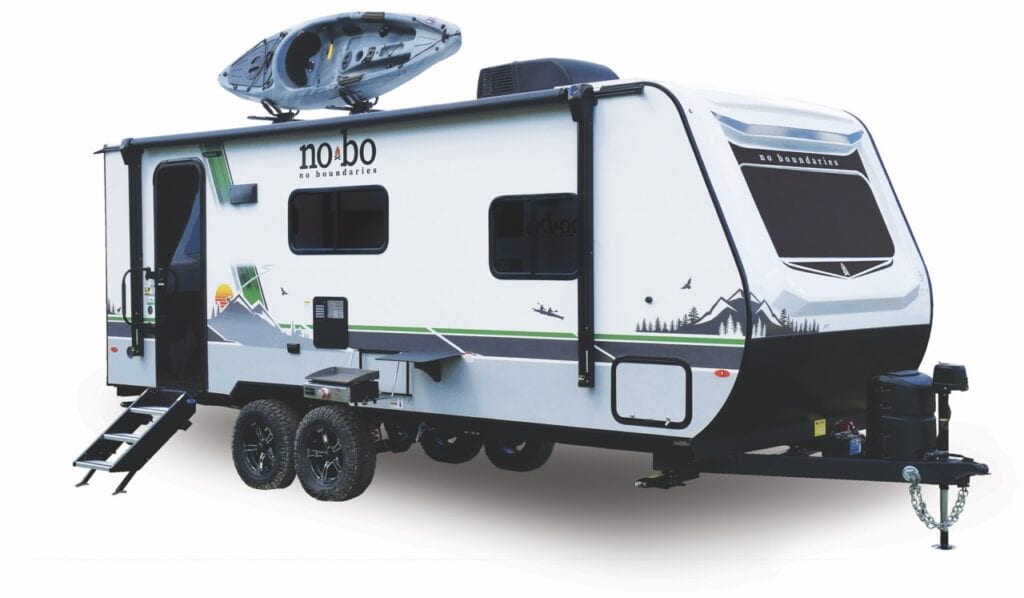
Another travel trailer that’s well suited for off-grid camping is the 24-foot, 8-inch long NoBo 19.6 ($48,546). It comes with a 200-watt solar panel, with a second as an option, feeding into a 30-amp charge controller and 2,000-watt inverter. The NoBo 19.6 features a queen Murphy bed up front, and a big jack-knife sofa in the slide. The breakfast bar provides plenty of countertop space, and the external kitchen expands eating options.
Ember RV Overland 191MSL
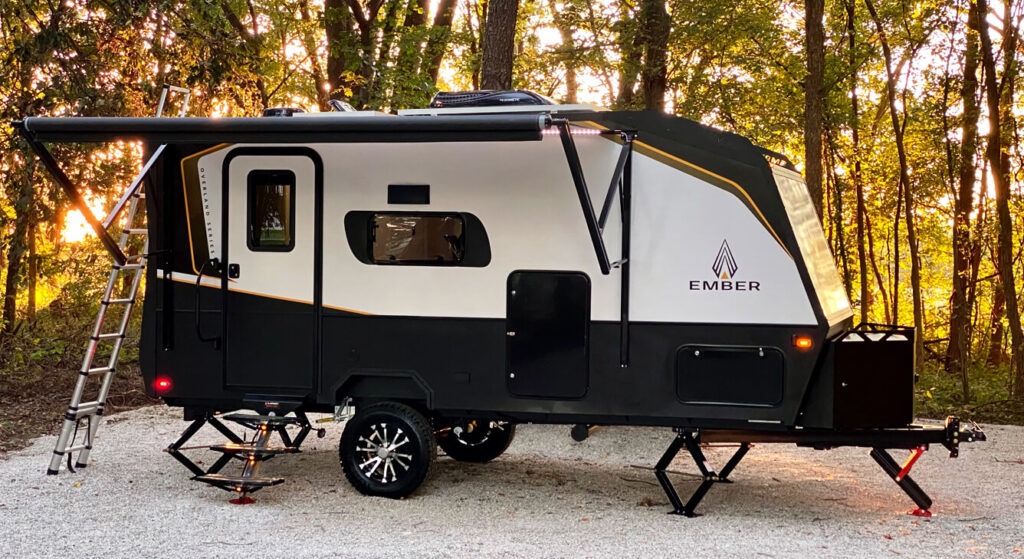
Ember RV‘s 22-foot, 6-inch long Overland 191MSL ($62,009) comes with dual 200-watt solar panels and a 50-amp solar controller. It also features a 74-by-46-inch rear cargo area with the EmberTrack E-Track System for storing gear. The 270Ah 12-volt Battle Born LiFePO4 battery is used as the base setup for off-grid camping. An additional Li-ion battery is an option.
Winnebago Revel

One of the best Class B motorhomes for extended off-grid adventure camping is the 2024 Winnebago Revel 4×4 ($245,463). It’s built on the turbodiesel Sprinter platform. The base Power Max system includes a 51-volt battery system anchored by an 8,400Wh Lithionics GTO LiFePO4 battery mated with dual 220W solar panels and a 3,600-watt inverter charger. The diesel engine also has dual alternators. With the max options, Winnebago says you can stay off-grid for up to a week using only battery power.
Winnebago Vista NPF

There are a number of Class A motorhomes that have the solar muscle to dry camp for days at a time. The gas-powered Winnebago Vista NPF (National Park Foundation Limited Edition) is a prime example, with a trio of 115-watt solar panels on the roof of this spacious 30-footer. Like other Winnie gas Class A products, the Vista NPF ($235,416) utilizes a Lithionics 320Ah battery to store energy when the 4kW Cummins Onan generator isn’t in play.
Coachmen Euro 25EU
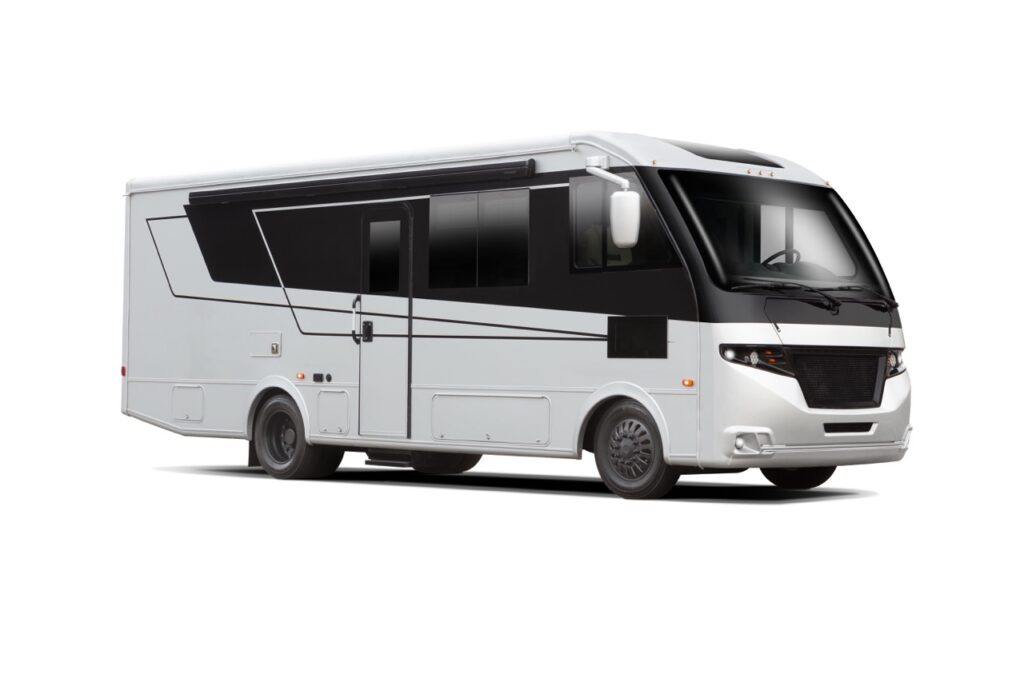
The Coachmen Euro ($159,999) is a brand-new gas Class A that provides the compactness, looks, and features of a European motorhome. But it does so with North American creature comforts. The 27-foot, 9-inch long motorcoach has a walkaround king bed, chef’s kitchen, and oversized shower. And that’s all in a more compact footprint than most motorhomes in this class. For dry camping/off-grid power it relies on a 300-watt solar panel and 55-amp converter, or firing up the 5.5Kw gas generator.
Boreas EOS-12
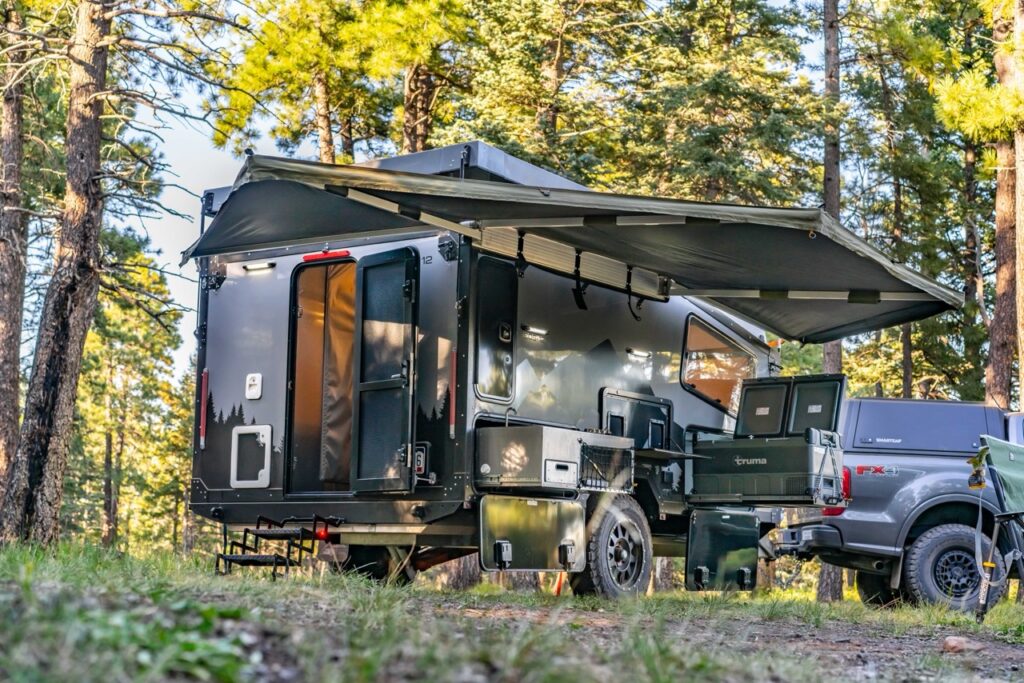
When it comes to off-road trailers that are well-equipped for true extended off-grid camping, the Boreas EOS-12 ($84,990) gets top marks. Mounted atop the 12-foot-long pop-top cabin is a 400-watt Go Power! solar system arrangement feeding into a pair of 270Ah Battle Born Gamechanger 3.0 Li batteries. The EOS-12 can be upgraded to 1,000 watts in panels and 1080Ah in batteries. That combo that should be enough to go more than a week relying just on the sun to provided energy.
InTech O-V-R

The 22-foot InTech O-V-R Expedition ($58,380) packs a lot of off-grid punch when it comes to battery power. This 7,500-pound (GVWR) all-aluminum trailer is available with inTech’s optional Off-Grid Package ($8,225). That means 400 watts of solar, mixed with an MPPT charger controller, two 110Ah Expion LiFePO4 batteries, and a 2,000-watt inverter. The interior layout is unique with a drop-down bunk above the dinette and twin beds in the front.
XploreRV X195
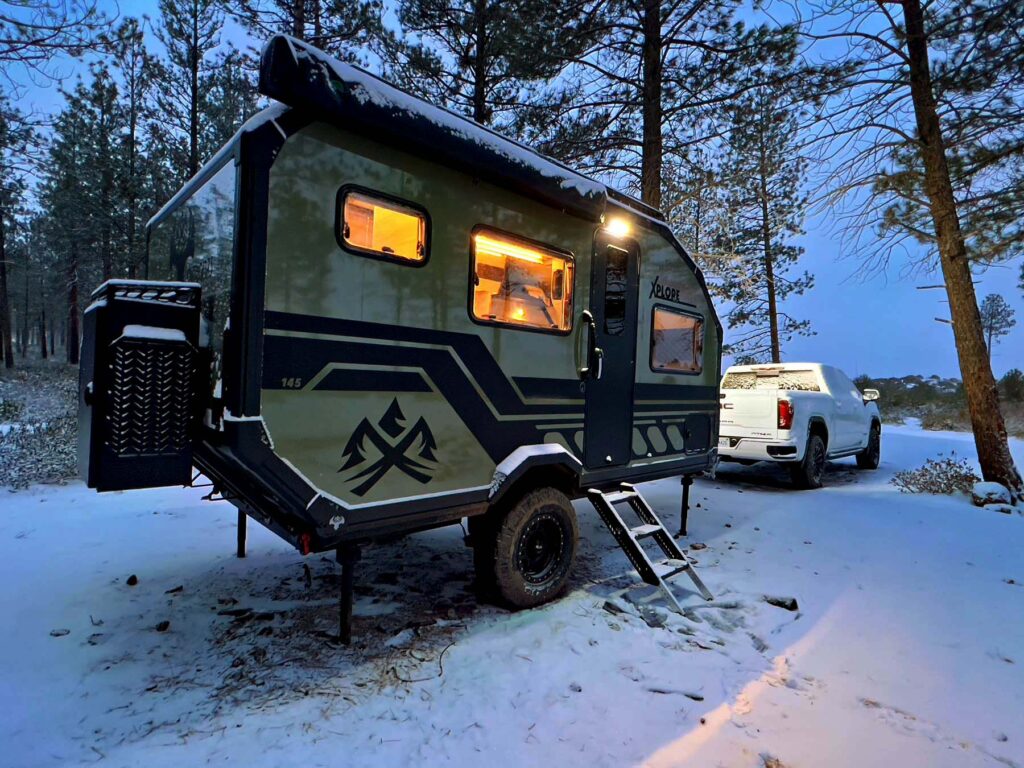
Another excellent RV that has plenty of battery/solar muscle is the XploreRV X195 ($143,000). The 26-foot, 9,920-pound (GVWR) X195 comes standard with GoPower! 360ah li-on battery storing the juice coming from a single 240-watt glass solar panel on the roof. Imperial Outdoors also offers two upgrade packages (720Ah and 1,080Ah) that double or triple the solar panels and the battery bank to provide a lot of electrical power long off-grid camping trips.



